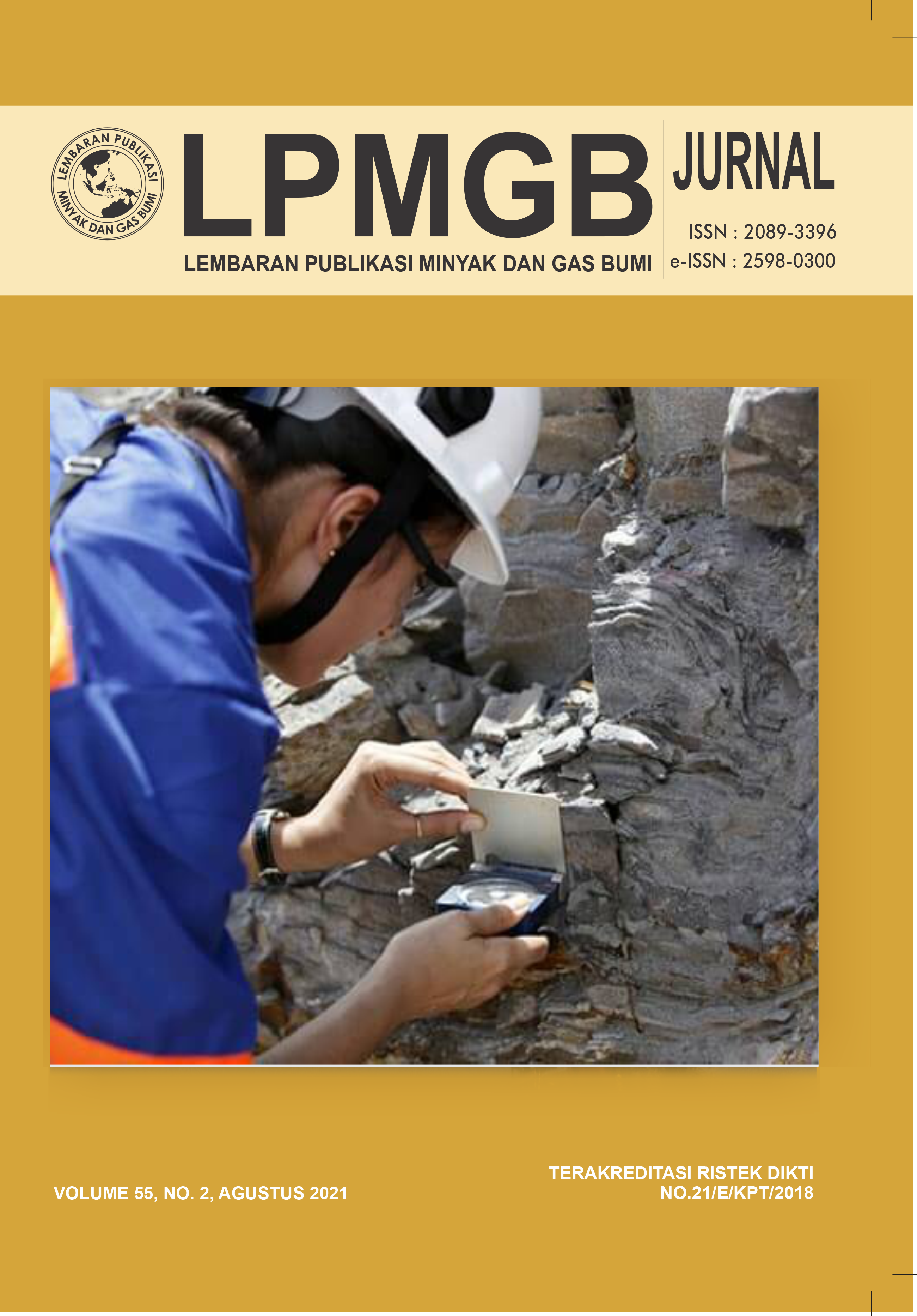Evolusi Busur Magmatik Pulau Jawa Bagian Timur sejak Eosen sampai Kuarter, Berdasarkan Analisis Provenance Batupasir Formasi Sambipitu
DOI:
https://doi.org/10.29017/LPMGB.55.2.607Kata Kunci:
formasi sambipitu, provenance, recycled orogen, busur magmatikAbstrak
Formasi Sambipitu merupakan batuan volkaniklastik berumur Miosen Awal-Akhir yang terbentuk di Cekungan Wonosari pada lingkungan paparan sampai slope yang dibatasi kerucut volkanik di sebelah Barat Laut dan tinggian Wonosari Platform di sebelah Tenggara. Pengamatan sequen stratigraphy dari outcrop menunjukkan proses trangresi di periode awal menuju regresi pada fase highstand dan selanjutnya periode trangresi kedua pada bagian akhir. Batupasir di daerah penelitian dapat dibagi menjadi 2, yaitu batupasir kasar dan batupasir halus, yang digunakan dalam analisis provenance untuk mempelajari dinamika sedimentasi dan tektonik daerah penelitian. Mekanisme sedimentasi didominasi oleh proses saltasi dan suspensi, dikarenakan kondisi lingkungan pengengdapan pada paparan dengan morfologi yang curam akan menyebabkan pergerakan aliran massa yang menghasilkan arus turbit sehingga endapan yang terbentuk didominasi oleh arus traksi. Berdasarkan diagram QFL Dickinson (1985), batuan sumber Formasi Sambipitu berasal dari 2 (dua) mekanisme, yaitu dari magmatic arc dan recycled orogen. Setting tektonik magmatic arc dikarenakan provenance berasal dari aktifitas volkanik bersifat asam-intermediet pada umur Oligo-Miosen di sebelah Barat Laut. Tiga sampel batuan pada recycled orogen berada pada fase pengenggelaman maksimum (maksimum flooding) dan kandungan mineral olivine yang hanya dijumpai 2 sampel diantara ketiganya menunjukkan adanya sumber batuan yang berasal dari volkanik yang bersifat basa/ultrabasa, atau bisa diinterpretasikan bahwa terdapat tinggian lain (paleo high) di sebelah Utara (daerah Bayat-Klaten/sejenisnya) yang berkontribusi mensuplai material sedimen ke Cekungan Wonosari. Evolusi magmatic arc sejak Eosen, dapat dibagi menjadi 3 tahapan, yaitu: 1) Eosen Island Arc; 2) Oligo-Miosen Volcanic Arc; dan 3) Quarternary Volcanic Arc.
Referensi
Asikin, S., 1974. Geological evolution of Central Java and its surroundings in terms of new tectonic paradign:Unpublished.
Bouma, A. H., 1962. Sedimentology of some flysch deposits: a Graphic Approach to facies interpretation. Amsterdam: Elsevier Publishing Company.
Bronto, S., 2010. Identifikasi gunung api purba pendul di perbukitan jiwo, kecamatan bayat, kabupaten Klaten-Jawa Tengah. Jurnal Geologi dan Sumberdaya Mineral, 20(1), pp. 3-13.
DeCelles, P. G. & Giles, K. A., 1996. Foreland basin systems. Basin Research, 8(2), p. 105–123.
Dickinson, W. R., 1985. Interpreting provenance relations from detrital modes of sandstones. Provenance of Arenites, Volume 148, pp. 333-361.
Hall, R., 1996. Reconstructing Cenozoic SE Asia. Geological Society, 106(1), p. 153–184.
Hamilton, W. B., 1979. Tectonics of the Indonesian region. Washington DC: USGS Professional Paper.
Hirawan, A., Bangun, A. S. V., Pratiwi, R. B. & Titisari, A. D., 2017. Characteristics of Basaltic Pillow Lava in Jarum Village, Bayat: Magma Evolution and Petrogenetic Model. Indonesia, p. 1395–1413.
Kadar, D., 1986. Neogen plantonic foraminiferal biostratigraphy of the South Central Java area, Indonesia. Jakarta: Directorate General of Geology and Mineral Resources, Geological Research and Development Centre.
Katili, J. A., 1975. Volcanism and plate tectonics in the Indonesian island arcs. Tectonophysics, 26
(3-4), p. 165–188.
Lokier, S. W., 2000. The Development of the Miocene Wonosari Formation, South Central Java. Indonesia, Indonesian Petroleum Association, pp. 1-6.
Lowe, D. R., 1982. Sediment gravity flow, II . Depositional models of high-density turbidity currents. Journal of Sedimentary Research, 52(1), p. 279–297.
Pantin, H. M. & Leeder, M. R., 1987. Reverse flow in turbidity currents : the role of internal solitons. Sedimentology, Volume 34, p. 1143–1155.
Parkinson, C. D., Miyazaki, K., Wakita, K., Barber, A.J., & Carswell, D.A., 1998. An overview and tectonic synthesis of the pre-Tertiary very-highpressure metamorphic and associated rocks of Java, Sulawesi and Kalimantan, Indonesia. The Island Arc, 7(1-2), pp. 184-200.
Pertamina-BEICIP, 1985. Hydrocarbon Potential of Western Indonesia: Pertamina.
Pickering, K. T. & Hiscott, R. N., 1985. Contained (reflected) turbidity currents from the Middle Ordovician Clotidorme Formation, Quebec, Canada : an alternative to the antidune hypothesis. Sedimentology, Volume 32, pp. 373-394.
Rahardjo , W., Sukandarrumidi & Rosidi, H., 1995. Peta Geologi Lembar Yogyakarta, Jawa. Yogyakarta: Pusat Penelitian Dan Pengembangan Geologi.
Rahardjo, W., Sukandarrumidi & Rosidi, H. M. D., 1995. Geological map of the Yogyakarta Quadrangle. Bandung: Geological Research and Development Centre.
Rahutama, A., 2014. Genetic stratigraphy of the Sambipitu Formation, a Miocene forearc basin-fill in Central Java, Indonesia, Cepu: PEM Akamigas.
Rutten, L., 1925. On the Origin of the Material of the Neogene Rocks in Java. Koninklijke Akademie van Wetenschappen Te Amsterdam, XXIX(1), p. 15–33.
Said, S., 1998. Facies and diagenesis of Sambipitu Formation sandstones, in Gunungkidul, Jogjakarta. Bandung: nstitut Teknologi Bandung.
Satyana, A., 2016. The emergence of pre-cenozoic petroleum system in east java basin: constraints from new data and interpretation of tectonic reconstruction, deep seismic, and geochemistry. Indonesia, Indonesian Petroleum Association.
Smyth, H. R., Hall, R. & Nichols, G. J., 2008. Significant Volcanic Contribution to Some Quartz-Rich Sandstone, East Java. Journal of
Sedimentary Research, Volume 78, p. 335–356.
Smyth, H. R., Nichols, G. J. & Hall, R., 2008. Cenozoic volcanic arc history of East Java , Indonesia : The stratigraphic record of eruptions on an active continental margin. In: A. E. Draut, P. D. Clift & D. W. Scholl, eds. Formation and Applications of the Sedimentary Record in Arc Collision Zones, p. 199-222.
Soeria-Atmadja, R., Maury, R.C., Bellon, H., Pringgoprawiro, H., Polve, M., & Priadi, B., 1994. Tertiary magmatic belts in Java. Journal of Southeast Asian Earth Sciences, Volume 9, p. 13–17.
Soeria-Atmadja, R., Suparka, S., Abdullah, C., Noeradi, D., & Sutanto, 1998. Magmatism in western Indonesia, the trapping of the Sumba Block and the gateways to the east of Sundaland. Journal of Asian Earth Sciences, 16(1), pp. 1-12.
Sribudiyani, Muchsin, N., Ryacudu, R., Kunto, T., Astono, P., Prasetya, I., Sapiie, B., Asikin, S., Harsolumakso, A.H., & Yulianto, I., 2003. The collision of the East Java Microplate and its implication for hydrocarbon occurrences in the East java Basin. Indonesia, Indonesian Petroleum Association.
Talling, P. J., Masson, D. G., Sumner, E. J. & Malgesini, G., 2012. Subaqueous sediment density flows: Depositional processes and deposit types. Sedimentology, 59(7), p. 1937–2003.
van Bemmelen, R. W., 1949. The Geology of Indonesia, The Hague: Government Printing Office : Martinus Nijhoff.
Visher, G. S., 1969. Grain Size Distribution and Depositional Processes. Journal of Sedimentary Petrology, Volume 39, pp. 1074-1106.
Wakita, K., 2000. Cretaceous accretionary-collision complexes in central Indonesia. Journal of Asian Earth Sciences, 18(6), pp. 739-749.
Widiyoko, I. & Barianto, D. H., 2018. Batuan asal dan paleogeografi formasi wungkal - gamping, klaten, jawa tengah dan formasi nanggulan, Kulon Progo, Daerah Istimewa Yogyakarta 1. Yogyakarta: Universitas Gadjah Mada.
Zachos, J., Pagani, M., Sloan, L., Thomas, E., & Billups, K., 2001. Trends, rhythms, and aberrations in global climate 65 Ma to present. Science, 292(5517), p. 686–693.











